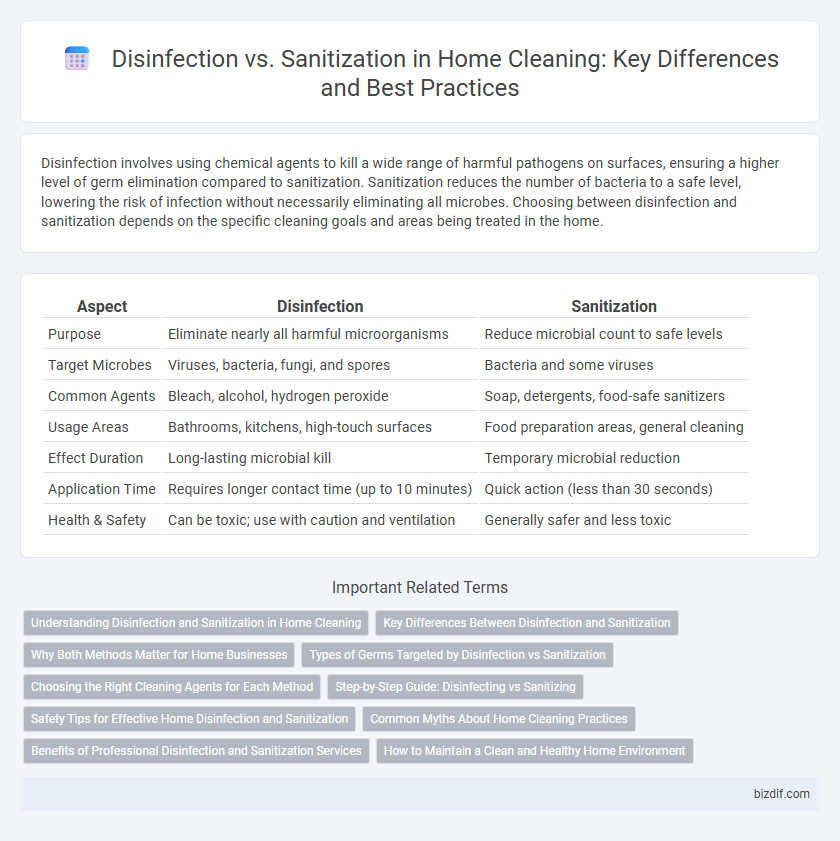Disinfection involves using chemical agents to kill a wide range of harmful pathogens on surfaces, ensuring a higher level of germ elimination compared to sanitization. Sanitization reduces the number of bacteria to a safe level, lowering the risk of infection without necessarily eliminating all microbes. Choosing between disinfection and sanitization depends on the specific cleaning goals and areas being treated in the home.
Table of Comparison
| Aspect | Disinfection | Sanitization |
|---|---|---|
| Purpose | Eliminate nearly all harmful microorganisms | Reduce microbial count to safe levels |
| Target Microbes | Viruses, bacteria, fungi, and spores | Bacteria and some viruses |
| Common Agents | Bleach, alcohol, hydrogen peroxide | Soap, detergents, food-safe sanitizers |
| Usage Areas | Bathrooms, kitchens, high-touch surfaces | Food preparation areas, general cleaning |
| Effect Duration | Long-lasting microbial kill | Temporary microbial reduction |
| Application Time | Requires longer contact time (up to 10 minutes) | Quick action (less than 30 seconds) |
| Health & Safety | Can be toxic; use with caution and ventilation | Generally safer and less toxic |
Understanding Disinfection and Sanitization in Home Cleaning
Disinfection eliminates nearly all harmful microorganisms on surfaces, targeting viruses, bacteria, and fungi, making it essential for preventing illness in home environments. Sanitization reduces the number of germs to safe levels as determined by public health standards, focusing on general cleanliness rather than complete eradication of pathogens. Effective home cleaning routines often combine sanitization for daily maintenance with disinfection after contamination or illness to ensure a healthier living space.
Key Differences Between Disinfection and Sanitization
Disinfection eliminates nearly all harmful microorganisms on surfaces by using strong chemical agents, whereas sanitization reduces bacteria to safe levels without complete eradication. Disinfection targets viruses, fungi, and bacteria, especially in high-touch areas like kitchen counters and bathroom fixtures, while sanitization primarily focuses on lowering microbial presence on items such as dishes and utensils. The choice between disinfection and sanitization depends on the required hygiene standard and the specific environment being cleaned.
Why Both Methods Matter for Home Businesses
Disinfection and sanitization play crucial roles in maintaining a safe environment for home businesses by targeting different levels of microbial control. Disinfection eliminates nearly all harmful pathogens, including viruses and bacteria, ensuring surfaces are safe from contagious agents, while sanitization reduces the number of germs to a safe level as defined by public health standards. Employing both methods enhances overall hygiene, protects employee and customer health, and supports compliance with health regulations, ultimately boosting business credibility and trust.
Types of Germs Targeted by Disinfection vs Sanitization
Disinfection targets a broader spectrum of harmful microorganisms, including viruses, bacteria, and fungi, effectively eliminating pathogens like Salmonella, E. coli, and Influenza viruses. Sanitization primarily reduces the number of bacteria on surfaces to safe levels, targeting common germs that cause illnesses but not necessarily eradicating all harmful viruses or spores. Understanding these distinctions is crucial for selecting the appropriate method based on the specific types of germs present in a home environment.
Choosing the Right Cleaning Agents for Each Method
Selecting the right cleaning agents for disinfection involves using EPA-registered disinfectants that effectively eliminate bacteria, viruses, and fungi on surfaces. Sanitization requires products that reduce microbial populations to safe levels, often using milder agents like quaternary ammonium compounds or alcohol-based solutions. Understanding the distinction and applying appropriate cleaners ensures maximum hygiene and safety in home cleaning routines.
Step-by-Step Guide: Disinfecting vs Sanitizing
Disinfecting eliminates nearly 100% of pathogens on surfaces using EPA-registered disinfectants with at least a 70% alcohol content or bleach solutions, requiring a wet contact time of 4-10 minutes. Sanitizing lowers germ counts to safe levels as per public health standards, often achieved with quaternary ammonium compounds or diluted bleach, applying for 30 seconds to 1 minute. Effective home cleaning protocols recommend first cleaning surfaces with soap and water, followed by sanitizing for routine maintenance or disinfecting when dealing with high-risk contamination, such as during illness outbreaks.
Safety Tips for Effective Home Disinfection and Sanitization
To ensure effective home disinfection and sanitization, use EPA-approved disinfectants targeting viruses and bacteria while following the manufacturer's contact time instructions for maximum germ elimination. Wear gloves and ensure proper ventilation during application to protect respiratory health and skin from harsh chemicals. Regularly clean high-touch surfaces like doorknobs, light switches, and countertops to reduce pathogen transmission effectively.
Common Myths About Home Cleaning Practices
Disinfection and sanitization are often confused, yet disinfection eliminates nearly all harmful microorganisms while sanitization reduces bacteria to safer levels, critical for effective home cleaning. Common myths include thinking that all cleaning products disinfect or that visible cleanliness guarantees a germ-free environment. Understanding these distinctions prevents improper use of cleaning agents and promotes healthier living spaces.
Benefits of Professional Disinfection and Sanitization Services
Professional disinfection and sanitization services use advanced EPA-approved products and techniques to eliminate harmful pathogens, reducing the risk of illness in your home. These services ensure comprehensive coverage of high-touch surfaces, providing a deeper clean than regular household methods. Trained technicians apply industry-standard protocols to maintain a safe and healthy living environment while saving you time and effort.
How to Maintain a Clean and Healthy Home Environment
Disinfection involves using chemicals to kill most germs on surfaces, effectively reducing the risk of infections, while sanitization lowers the number of germs to a safe level as judged by public health standards. Regularly disinfect high-touch areas like doorknobs, light switches, and countertops with EPA-approved disinfectants to maintain a healthy home environment. Consistently cleaning surfaces before disinfecting and ensuring proper ventilation helps prevent the spread of bacteria and viruses, promoting overall household hygiene.
Disinfection vs Sanitization Infographic

 bizdif.com
bizdif.com